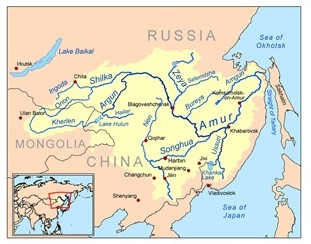The Amur Leopard (scientific name: Panthera pardus Orientalis, common names Far East leopard, Manchurian leopard or Korean leopard, the latter because some are supposed to inhabit North Korea.), subject of the video in this critique, bears the dubious distinction as the world’s most endangered of the great cats for being the northernmost-ranging of the widely distributed leopard family. Whereas leopard populations are stable in the savannas of Africa and the temperate broadleaf and mixed forests of South Asia, this subspecies inhabits the desolate and remote wilderness of the Amur region. By one estimate, there may be only 35 animals left. (World Wildlife Fund, 2010a; Poston, 2009; Amur Leopard and Tiger Alliance, 2008).

The very vastness and remoteness of the Amur region (see Figure 1) make access and conservation inordinately difficult. The Amur River, from which the region takes its name, is the border between Russia’s Far East-Primorskii region and China’s northern Tzilin and Heilundzyan Provinces. This has made the region a flashpoint for border conflicts. Since the land area is comparable to Alaska, monitoring of a mere three dozen specimens and policing of hunters or poachers is that much more difficult. Happily, as the video shows, Russia’s military units in the area are happy enough to cooperate with nonprofits, such as the WWF, in conservation efforts. (Black, 2005; World Wildlife Fund, 2010a).
The video itself (Hötte, 2008) is informative enough but lacks the voice-over and production values that could have: a) stimulated a call to action; b) impacted favorably with conservation enthusiasts and thus provoked funding support; and, c) all because the ALTA production does not come close to matching the compelling cinematography of National Geographic, as exemplified in treatment of the snow leopard in India’s Himalayan foothills (NationalGeographic, 2009).
The four-minute version on YouTube starts out promisingly enough with plain text locating the Amur basin near Vladivostok, a city name presumably familiar enough to the well-informed viewer. The first few segments show, in succession, Amur leopards in the wild captured on video camera traps, the threat posed by hunters and poachers who desire the pelt, as well as how unchecked forest fires destroy their habitat, Field personnel of the 13 international and Russian NGOs have cooperated since 1998 under the umbrella of the Amur Leopard and Tiger Alliance (n.d.) to tag the leopards, do genetic and health research, confiscate firearms from hunters, carry out awareness-building projects in the area, and raise funds by selling a computer or mobile phone wallpaper, footprint casts, etc. All these in the service, apparently, of conserving a subspecies with no particular redeeming value except that it is on the brink of extinction.
Michiel Hötte (2008) of the Zoological Society of London directed this short documentary but, were it not for the footage shot in the remote fastness of the Amur range, it would be little better than the millions of home videos that litter YouTube. Providing some soothing elevator music for a soundtrack harks back to the travelogues of decades back when video production was taking its first faltering steps. Perking up the interest-only of diehard conservationists with nothing better to do, this piece on the Amur leopard would not even qualify as a conversation stopper. Lacking a voice-over and any compelling call-to-action device, the video just peters off at the end. Surely, the NGOs that brave the hostility of the Chinese, the cold of the Siberian climate, and the bleak loneliness that is life around the Amur deserved better than this.
References
Amur Leopard and Tiger Alliance (n.d.) Alta Amur Leopard Conservation. Web.
Black, R. (2005). Rare leopard ‘faces exextinction. Web.
Hötte, M. (2008). ALTA Amur Leopard Conservation. Web.
Kmusser (2009). Amur river drainage basin. Creative Commons. Web.
NationalGeographic (2009). Searching for the snow leopard. Web.
Poston, L. (2009). A rare photo of three Amur leopards offers hope for the world’s most endangered cat: Three individuals represent almost 10 percent of population. Web.
World Wildlife Fund (2010a). Amur leopard – The cat that stalks alone: An endangered solitary hunter. Web.